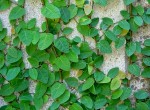Native to East Asia, this fast-growing woody evergreen vine is a member of the mulberry family, Moraceae, that also includes banyan, osage orange, and rubber plant. It grows up to 40′ long and can creep on the ground or climb on trees, fences, walls and other structures by means of aerial roots that produce a sticky substance that hardens when dry. The heart-shaped juvenile leaves are up to 1″ long while the mature leaves are elliptal to oblong and up to 4″ long. Inconspicuous flowers produce pear-shaped purple fruits that are ornamental and edible. Creeping fig does well in containers indoors but does not produce flowers and fruits. It is an excellent houseplant including as topiary and is very decorative when grown on a wall outdoors.. The genus name, Ficus, is the Latin name for the edible fig, F. carica. The specific epithet, pumila, is the Latin word meaning dwarf and refers to the size of the leaves.
Type: Tender,woody evergreen vine.
Bloom: Inconspicuous, rarely seen; fruit small and fig-like
Size: 15’ H
Light: Prefers part shade put tolerates full sun.
Soil: Average, mediummoist, well-drained; tolerates drought and is better behaved in lean soil and dry conditions
Hardiness: Zones 8-11
Care: Trim back when growth excessive.
Pests and Diseases: Generallyhealthy but susceptable to aphids, mealbugs, scale, spider mites, and thrips,
Propagation: Layering; cuttings.
Outstanding Selections:
‘Minima’ (smaller leaves and less vigorous than species)
var. quercifolia (oak-lead leaves)
‘Curly’ (crinkled leaves)
‘Variegata’
‘Snowflake’ (variegated leaves)


